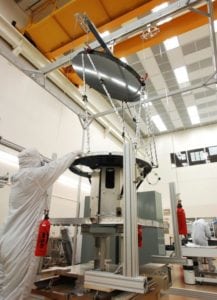Ball Aerospace Weather Instrument Celebrates Third Anniversary

GMI instrument being constructed at Ball Aerospace. Photo: Ball Aerospace.
The Global Precipitation Measurement (GPM) Microwave Imager (GMI), designed and built by Ball Aerospace for NASA’s Goddard Space Flight Center, is entering its fourth year of service. Designed as a three-year mission, GMI has performed successful operations on orbit while exceeding its performance requirements. The GPM spacecraft that hosts the GMI instrument is a joint effort between NASA and the Japan Aerospace Exploration Agency (JAXA) to provide frequent, near-global precipitation information critical for improving weather forecasting and protecting lives and property.
The GMI instrument is a multi-channel, conical-scanning, microwave radiometer serving an essential role in the near-global coverage and frequent revisit time requirements of the GPM mission.
Ball designed, built and tested GMI, and provided pre- and post-launch support for the instrument. GMI’s high-frequency channels measure small particles of ice, snow and rain in the atmosphere. When combined with the JAXA-built dual-frequency precipitation radar, these instruments provide comprehensive data to produce global rain maps and climate research data products. GMI enables the core spacecraft to serve as both a precipitation standard and a radiometric standard for the other spacecraft in the GPM constellation. By serving as the calibration standard in the GPM constellation, Ball’s GMI instrument helps to ensure the accuracy and precision of other instruments.